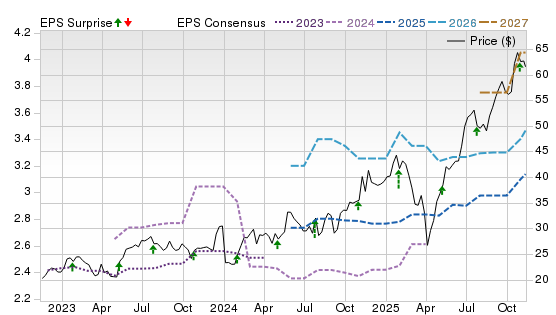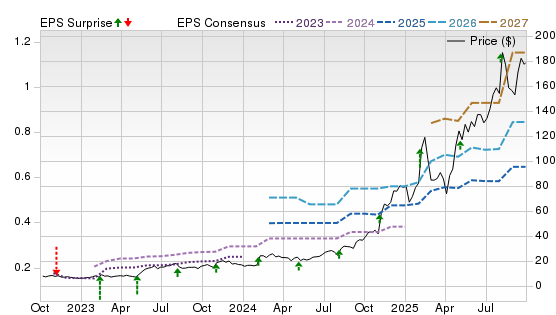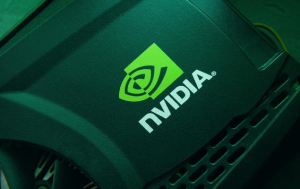5 Best AI Stocks to Buy Today
| Company (Ticker) | 12 Week Price Change | Forward PE | Price | Proj EPS Growth (1 Year) | Projected Sales Growth (1Y) |
|---|---|---|---|---|---|
| Micron Technology (MU) | 96.14% | 13.61 | $222.90 | 102.56% | 45.76% |
| Flex (FLEX) | 7.65% | 18.35 | $58.34 | 18.40% | 4.77% |
| Lam Research (LRCX) | 38.22% | 29.92 | $147.43 | 15.64% | 14.06% |
| Teradyne (TER) | 38.04% | 47.32 | $168.53 | 7.45% | 6.85% |
| Palantir Technologies (PLTR) | 4.02% | 230.48 | $163.98 | 77.07% | 54.09% |
*Updated on November 19, 2025.
Micron Technology (MU)
$222.90 USD -5.60 (-2.45%)
3-Year Stock Price Performance

Premium Research for MU
- Zacks Rank
- Strong Buy 1
- Style Scores
C Value A Growth A Momentum A VGM
- Market Cap: $256.86B (Large Cap)
- Projected EPS Growth:102.53%
- Last Quarter EPS Growth:65.32%
- Last EPS Surprise:5.94%
- Next EPS Report date:Dec. 17, 2025
Our Take:
Micron is a leading supplier of DRAM, NAND and high-bandwidth memory (HBM) that underpins AI accelerators and data-center servers. A Zacks Rank #1 (Strong Buy) with Style Scores of A for Growth and Momentum and C for Value signals rising estimates with supportive price action, though not the cheapest on traditional metrics. That mix often precedes continued estimate revisions and outperformance for cyclical leaders.
Micron is now positioned at the heart of AI build-outs. It is shipping HBM3E at scale and is designed into NVIDIA’s GB-product family. Being the only U.S.-based memory manufacturer gives it a competitive edge amid ongoing tariff uncertainty. This linkage to AI GPUs, plus improving memory pricing, strengthens visibility into the upcycle.
Micron’s Price, Consensus & EPS Surprise chart shows shares breaking out as 2026–2027 EPS consensus rises sharply above previous years. With AI-driven demand reinforcing the cycle, MU’s quantitative setup aligns with improving fundamentals.
Flex (FLEX)
$58.34 USD +0.77 (1.34%)
3-Year Stock Price Performance

Premium Research for FLEX
- Zacks Rank
 Buy 2
Buy 2
- Style Scores
A Value B Growth C Momentum A VGM
- Market Cap:$21.29B (Large Cap)
- Projected EPS Growth:18.49%
- Last Quarter EPS Growth:9.38%
- Last EPS Surprise:5.33%
- Next EPS Report date:Feb. 4, 2026
Our Take:
Flex is a global design-to-manufacturing partner that builds complex hardware and infrastructure. Its new AI Infrastructure Platform integrates power, cooling and compute and speeds up deployment of high-density AI data centers by almost 30%. A Zacks Rank #2 (Buy) with Style Scores of A for Value, B for Growth and C for Momentum suggests attractive valuation and healthy revisions, even if near-term price action is mixed.
Strategically, Flex is leaning into AI-driven capacity needs with modular, pre-engineered systems that can cut deployment timelines, supported by its global footprint and services. The company highlighted the platform at the OCP Summit, underscoring a push into higher-value data-center solutions.
On the chart, FLEX’s price has pushed to new highs while 2026–2027 EPS estimates trend higher after a mid-cycle lull. Stabilization in the Automotive and Renewables markets and growth in Medical Devices, Optical and Satcom are expected to support its long-term growth.
Lam Research (LRCX)
$147.43 USD +4.19 (2.93%)
3-Year Stock Price Performance

Premium Research for LRCX
- Zacks Rank
 Buy 2
Buy 2
- Style Scores
D Value A Growth B Momentum B VGM
- Market Cap:$179.91B (Large Cap)
- Projected EPS Growth:15.70%
- Last Quarter EPS Growth:-5.26%
- Last EPS Surprise:4.13%
- Next EPS Report date:Feb. 4, 2026
Our Take:
Lam Research supplies the etch and deposition tools essential to advanced logic, 3D NAND and HBM manufacturing, the core plumbing that makes modern AI chips possible. A Zacks Rank #2 with Style Scores of A for Growth, B for Momentum and D for Value reflects strong estimate trends and price support despite a richer multiple.
Lam Research expects strong revenue growth on rising demand for chipmaking tools tied to AI processors, while advancing technologies like backside power-delivery and other transistor innovations. These moves are expanding its served available market at leading nodes. Recent outlooks highlight AI-linked WFE strength into 2026.
LRCX’s chart shows shares recovering with 2026–2027 consensus moving up meaningfully from mid-cycle lows. It expects softer domestic China investment in 2026 to be fully offset by continued strength across all three device segments, a significant cushion given that China still drives the majority of its revenue.
Teradyne (TER)
$168.53 USD +4.81 (2.94%)
3-Year Stock Price Performance

Premium Research for TER
- Zacks Rank
 Buy 2
Buy 2
- Style Scores
D Value F Growth B Momentum F VGM
- Market Cap: $25.64B (Large Cap)
- Projected EPS Growth: 7.45%
- Last Quarter EPS Growth:49.12%
- Last EPS Surprise: 8.97%
- Next EPS Report date:Feb 4, 2026
Our Take:
Teradyne is a leader in automated test equipment used to validate advanced compute, memory and AI chips, with a robotics exposure that adds optionality. A Zacks Rank #2 and Style Scores of D for Value, F for Growth and B for Momentum indicate investors are rewarding TER’s earnings trajectory despite a richer multiple. While quarterly swings persist, its positioning at the verification layer of the AI stack keeps it leveraged to node transitions and HBM ramps.
Management recently pointed to strong AI-related demand in Compute and Networking test, with third quarter results indicating robust Memory strength backed by AI applications of HBM/DRAM. Over the first three quarters of 2025, operating cash flow increased to $392.8 million.
On the chart, TER’s price has climbed sharply this year as out-year (2026–2027) estimates grind higher. With the AI test cycle gaining traction, Teradyne’s margins will be supported by an improved product mix.
Palantir Technologies (PLTR)
$163.98 USD -3.35 (-2.00%)
3-Year Stock Price Performance

Premium Research for PLTR
- Zacks Rank
 Buy 2
Buy 2
- Style Scores
F Value A Growth A Momentum B VGM
- Market Cap: $398.82B (Large Cap)
- Projected EPS Growth:78.05%
- Last Quarter EPS Growth:38.46%
- Last EPS Surprise:23.53%
- Next EPS Report date:Feb. 2, 2026
Our Take:
Palantir builds data-integration and analytics software platforms. Its AI Platform (AIP) is driving accelerated adoption across government and commercial customers. A Zacks Rank #2 with Style Scores of A for Growth and Momentum and F for Value captures powerful revisions and price strength, albeit at a premium valuation. This frames PLTR as a high-beta way to play enterprise AI software adoption.
Palantir lifted its outlook for 2025 again on surging AIP demand, with management characterizing growth as “otherworldly.” Its commercial business doubled in the United States, supporting sustained scale and profitability. Meanwhile, the Government business provides a durable base.
The chart shows a volatile stock that has broken higher as 2026–2027 estimates inflect upward after a period of stagnation. Its modular, usage-based pricing lowers entry barriers, letting new clients adopt its tools incrementally and expand spending naturally as their data needs grow and platform reliance deepens over time.
Methodology
The Zacks Rank is a proprietary stock-rating model that uses trends in earnings estimate revisions and earnings-per-share (EPS) surprises to classify stocks into five groups: #1 (Strong Buy), #2 (Buy), #3 (Hold), #4 (Sell) and #5 (Strong Sell). The Zacks Rank is calculated through four primary factors related to earnings estimates: analysts' consensus on earnings estimate revisions, the magnitude of revision change, the upside potential and estimate surprise (or the degree in which earnings per share deviated from the previous quarter).
Zacks builds the data from 3,000 analysts at over 150 different brokerage firms. The average yearly gain for Zacks Rank #1 (Strong Buy) stocks is +23.62% per year from January, 1988, through June 2, 2025.
Selections for Best AI Stocks are based on the current top ranking stocks based on Zacks Indicator Score. For this list, only companies that have average daily trading volumes of 100,000 shares or more and at least five analysts covering the stock were considered. All information is current as of market open, Nov. 19, 2025.
Guide to AI Stocks
The classification of “AI Stocks” is actually quite broad, ranging from companies that provide the essential hardware, companies that create the software to run Large Language Models, and a whole host of other industries and companies that are creating the Artificial Intelligence ecosystem. All stand to gain – or lose – depending on the fortunes of AI tech.
Types of AI Stocks
Hardware (GPUs, Chips) Stocks – NVIDIA, AMD, TSMC, Broadcom
The backbone of AI is raw computing power, and this comes primarily from specialized chips like graphics processing units (GPUs) and AI-focused accelerators. NVIDIA (NVDA) is the undisputed leader in GPUs used for training large language models.
Advanced Micro Devices (AMD) is a rising competitor, with its MI300 series targeting data center AI workloads. Taiwan Semiconductor Manufacturing Co. (TSMC) doesn’t make its own chips but manufactures advanced nodes for nearly every big tech firm—including Apple, Nvidia, and AMD—making it critical to the global AI supply chain. Broadcom (AVGO) has carved a niche in custom ASICs (application-specific integrated circuits) for hyperscale cloud providers, which value tailored chips that reduce energy use and maximize throughput.
These companies benefit from structural demand for more computing capacity, but they also face geopolitical risks such as U.S.-China export restrictions and cyclical swings in semiconductor demand.
AI Cloud & Infrastructure – Microsoft, Amazon, Alphabet
Building AI applications at scale requires massive computing infrastructure. Azure from Microsoft (MSFT) has become a leader by integrating OpenAI’s models directly into its cloud offerings, giving it a first-mover advantage in AI enterprise adoption. Amazon Web Services, a subsidiary of Amazon (AMZN) is deploying its in-house Trainium and Inferentia chips, aiming to lower costs for AI workloads while retaining dominance in cloud services. Alphabet’s (GOOG) Google Cloud is leaning heavily on its proprietary Tensor Processing Units (TPUs) and Gemini AI models to differentiate itself.
Investing in these players is less about speculative growth and more about diversified tech giants whose AI investments bolster an already profitable core business.
Enterprise AI Software & Analytics – Palantir, C3.ai, Adobe, Snowflake
AI isn’t just about hardware; software platforms are where businesses actually apply machine intelligence. Palantir (PLTR) powers decision-making for defense and large corporations with its Foundry and Gotham platforms. C3.ai (AI) focuses specifically on AI-driven applications across industries like energy, finance, and manufacturing. Adobe (ADBE) has integrated AI across its creative suite (e.g., Firefly in Photoshop), while Snowflake (SNOW) has added AI-enabled analytics to its cloud data warehousing business.
These stocks tend to have higher growth potential but also higher risk, as adoption timelines and customer budgets can vary widely.
Cybersecurity AI – CrowdStrike
The rise of AI also heightens cyber risks. CrowdStrike (CRWD) leads in AI-powered threat detection, using machine learning to flag suspicious behavior across millions of endpoints in real time. With ransomware and nation-state attacks increasing, demand for AI-driven security remains strong. Cybersecurity names often benefit from recurring revenue models, which may help smooth out volatility compared to hardware peers.
Benefits and Risks of AI Stocks
Benefits:
- Secular Growth: AI adoption is still in early innings, with enterprise use cases expanding rapidly.
- Diversified Exposure: Investors can target infrastructure, software, or services depending on risk tolerance.
- First-Mover Advantage: Leaders like NVIDIA and Microsoft are shaping the ecosystem, creating strong economic moats.
Risks:
- Valuations: Many AI leaders are priced for perfection, leaving little margin of safety.
- Hype Cycle: Investor enthusiasm may outrun near-term fundamentals, creating bubble risk.
- Regulation: Governments are exploring AI rules around privacy, bias, and national security, which could reshape business models.
- Competition: Barriers to entry are high, but fast innovation means today’s leader can quickly lose ground.
How to Choose AI Stocks
When evaluating AI stocks, consider:
- Revenue Mix: How much of the company’s growth is truly driven by AI vs. traditional segments?
- Moat & Differentiation: Does the company control unique technology (like NVIDIA’s CUDA software ecosystem)?
- Customer Adoption: Look for companies with recurring contracts or wide adoption across industries.
- Financial Health: Strong balance sheets matter in a capital-intensive industry.
- Valuation Metrics: Compare price-to-earnings (P/E) ratio, price-to-sales (P/S) ratio, and forward growth projections to industry peers.
How to Invest in AI Stocks
There are multiple entry points depending on your goals:
- Direct Stock Picks: Best if you want concentrated exposure to specific company leaders or disruptors.
- AI Exchange-Traded Funds (ETFs): ETFs such as Global X Robotics & Artificial Intelligence ETF (BOTZ) or iShares Robotics and AI ETF (IRBO) provide diversification by investing in a broad range of companies in the AI space.
- Broad Tech ETFs: Like Invesco QQQ (QQQ) or Vanguard Information Technology ETF (VGT), offering AI exposure as part of a bigger tech basket.
- Dollar-Cost Averaging (DCA): A strategy to smooth price volatility by buying at regular intervals AI stocks or funds.
- Long-Term Holds: Since AI is a multi-decade trend, investors who can weather short-term swings may see the best results.
AI Stocks Alternatives
If you want exposure to AI without betting on a single stock:
- ETFs: Offer diversification and reduce single-company risk.
- Private Markets: Startups in robotics, generative AI, and enterprise AI could offer upside, though access is limited to accredited investors, which face income or licensing limitations (such as a net worth of $1 million, excluding primary residence, plus a high annual income – $300,000 if married.
- Picks-and-Shovels Plays: Companies supplying infrastructure, like power management (e.g., Eaton) or data center REITs (e.g., Equinix), benefit indirectly from AI growth.
Strategies for AI Stocks Moving Forward
- Barbell Approach: Combine stable mega-caps (Microsoft, Nvidia) with speculative names (Quantum Computing Inc., Credo) for balanced exposure.
- Rebalancing: Trim positions after strong rallies to lock in gains and redeploy into underweighted sectors.
- Monitor Earnings: Focus on whether AI adoption translates into sustainable revenue growth.
- Look Beyond the U.S.: Consider emerging AI leaders in Europe and Asia for diversification.
- Stay Agile: AI is evolving rapidly; reassess holdings every quarter as new winners emerge.
Frequently Asked Questions About AI Stocks
Are AI stocks overvalued?
Many AI leaders are priced at steep multiples compared to the broader market. That doesn’t mean all are bubbles, but investors should separate hype from earnings-driven growth.
What is the forecast for AI stocks?
Most analysts expect AI demand to expand through at least the next decade, with data center spending, AI-as-a-service, and AI-enabled enterprise tools driving revenue.
What metrics best signal AI efficacy?
- Growth in AI-specific revenue lines.
- Gross margin improvements tied to AI.
- Customer retention and expansion.
- Evidence of scale: Contracts, partnerships, recurring revenue.














